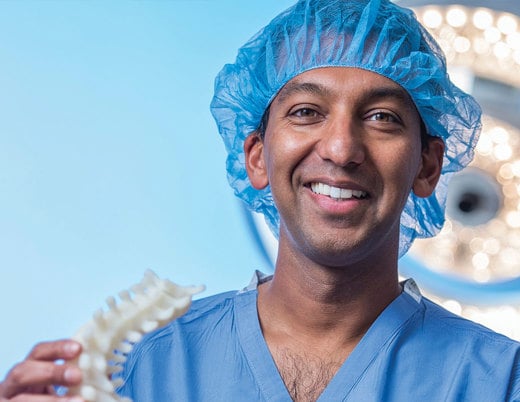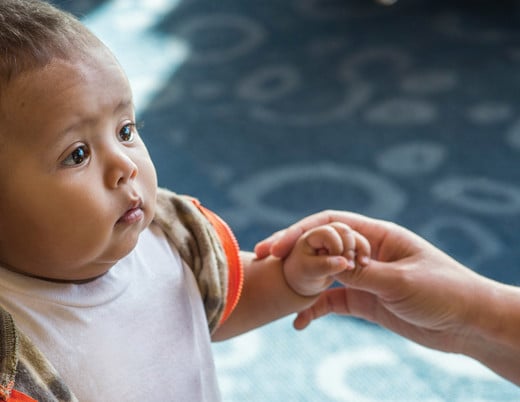How has the Mazor X robot, and the team of experts behind it, revolutionized spinal surgery at Children’s Hospital Colorado?
In early 2024, the spinal surgery team at Children’s Hospital Colorado achieved a significant milestone: 500 robot-assisted spine surgeries. Led by Mark Erickson, MD, Medical Director of the Children’s Colorado Spine Program, the team, which counts the Mazor X robot among its members, has paved a new path for greater adoption of robot-assisted surgery in the pediatric arena.
This work is led by Dr. Erickson and a core team of providers who have become experts in using the robot (better known as Mazie) to address everything from deformities and traumatic injuries to spinal tumors and infections. By employing the robot, the team can plan the surgery in detail before making any cuts and ensure real-time accuracy and precision when placing corrective screws.
How Mazie works
The surgery begins before the patient even enters the operating room. The team performs a “scan and plan,” during which they use scans of the patient’s spine and create a preoperative plan using Mazie’s robotic guidance system. During surgery, one of Mazie’s arms attaches to the operating table while the other stabilizes the patient’s spine — a function that is incredibly important both in executing surgical plans and in promoting better healing after surgery. The team can also adjust the plan during the operation as needed.
Mazie’s capabilities, combined with the team’s deep experience and coordinated approach to surgery, creates exceptional precision. And because the spine is such a vital part of the body, that is crucial to patient outcomes, Dr. Erickson says.
“The most relevant thing that we're trying to protect is the spinal cord. So, for example, we're putting a 3-millimeter drill into those vertebrae through a 4-millimeter pedicle. That means we have one millimeter of error, right? Pretty tiny,” he explains. “The precision that's afforded by the robot is tremendous. Previously in those smaller areas and the cervical spine and the upper thoracic spine, we would just say it's too risky.”

A collaborative approach to spine surgery
While Mazie certainly lends a significant hand in allowing such precision and accuracy, it’s the team’s experience that has made Children’s Colorado a leader in adapting this robot for pediatric use. Dr. Erickson has worked closely with Ryan Ballard, PA, and a core team of experts to streamline their approach to robot-assisted surgery. This ensures that surgeries always run as smoothly as possible and that any providers who are new to working alongside Mazie can quickly get up to speed.
“Everybody has to be able to do different jobs depending on what the situation calls for. That's why the team is so key,” Dr. Erickson says. “And Ryan and I have designed a way we set up the table and we set up the room so that every teammate we bring in that day can assimilate and use the tools. The concept of making sure that our team understands what we're doing is huge, and that starts from the get-go.”
“We use it in every case, so we know every nuance. And then for us, the more challenging cases are not that tremendously different.”
Mark Erickson, MD
This protocol, and others the team has put in place over the course of nearly five years working with the Mazor X robot, have helped inform others aiming to adopt robot-assisted surgery. Children’s Colorado is one of just four institutions around the country using Mazor X in the pediatric space and conducting research on best practices and efficacy. Together, providers across these hospitals are working to ensure everyone has the information they need to improve spinal surgery for kids and adults. So far, the group has published nearly 15 articles, with more on the way.
Even among these peers though, Dr. Erickson’s approach to Mazor X is unique. Where others typically only employ Mazie for particularly complex cases, he considers Mazie a permanent member of the team.
“I try to use it on every case. And there's a reason for that. If the only time I use it is the most difficult cases — say 1 out of 10 or 2 out of 10 — the team’s not as ready to do it,” he says. “We use it in every case, so we know every nuance. And then for us, the more challenging cases are not that tremendously different.”
The future of robot-assisted surgery
Already, Mazie has made a huge impact on the team and patients. And soon, Dr. Erickson expects that impact to grow.
“It's kind of overwhelming to think about how it's changed our team, but it's pretty dramatic,” he says. “In the very near future, it’s going to change even more. We will be able to do things like take out vertebra or help resect tumors, or better align and stabilize the spine towards the benefit of the patient. … Within the next three to five years, it’s really going to even further advance.”
Featured researchers

Mark Erickson, MD
Medical Director, Spine Program
The Orthopedics Institute
Children's Hospital Colorado
Professor, fellowship director
Orthopedics
University of Colorado School of Medicine

Ryan Ballard, PA-C
Certified physician assistant
The Orthopedics Institute
Children's Hospital Colorado
Instructor
Orthopedics
University of Colorado School of Medicine





 720-777-0123
720-777-0123










